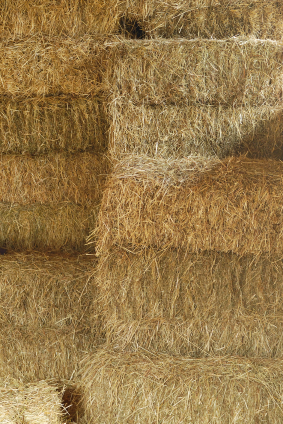 This construction method uses bales of straw for walls or wall insulation, which are usually covered in stucco. In an agricultural province like Manitoba, the use of straw bales in building homes is a boon for the environment in a number of ways.
This construction method uses bales of straw for walls or wall insulation, which are usually covered in stucco. In an agricultural province like Manitoba, the use of straw bales in building homes is a boon for the environment in a number of ways.
Straw bale homes have significantly higher insulation value than standard house walls filled with fibreglass, cellulose, or other fibres. Straw bale homes will have an insulation value of R28 or higher compared to R20 for an insulated 2×6 wall.
As well, the thermal mass of the walls will convey an even greater energy advantage, since the walls can take hours to warm up or cool down. In one study by CMHC, straw bale homes used over 20% less space heating energy than conventional homes. (1)
Straw bale construction uses up a “waste” product that might otherwise be burned (with the resulting release of carbon into the atmosphere).
Straw bales may replace other building materials, such as wood, which have climate change costs attached to their use, from the cutting of trees to the need to transport the materials much further. (2)
Straw bale construction can be traced back to the mid-1800s in Nebraska, but has seen a recent revival. Estimates suggest more than 1000 straw bale homes were built in Canada in 2000, with numbers rising each subsequent year. (3)
New homes
Straw bale construction focuses solely on the walls of a home, while foundations, floors, roofs, electrical and plumbing systems remain the same as conventional homes.
There are two types of straw bale construction:
- Load bearing – Load bearing walls completely support the roof and any second storey floors without posts or frames for support. The straw bales provide both structure and insulation. (4) Load bearing can be more labour intensive and require more planning. It may also be more challenging to get building approvals for this style. However, it has a small ecological footprint (especially if the straw is locally sourced). (5)
- Post and beam – In this style, a wood structure usually provides the load bearing function, while the straw bales fill spaces between posts or wrap the entire structure. The straw bales provide insulation and the surface for plaster. (6) It is generally easier to get approvals for this more conventional style.
Existing homes
Straw bales can be used to wrap the exterior of an old poorly insulated home. It is also possible to build a straw bale extension to an existing conventional home. (7) This option may be generally more appropriate for buildings on farms.
Before adding insulation to the exterior of a home, you must ensure that there is a good, well-placed vapour barrier. Without a good air seal, moisture will escape and then freeze and condense within the new insulation layer. This can cause problems such as mould.




